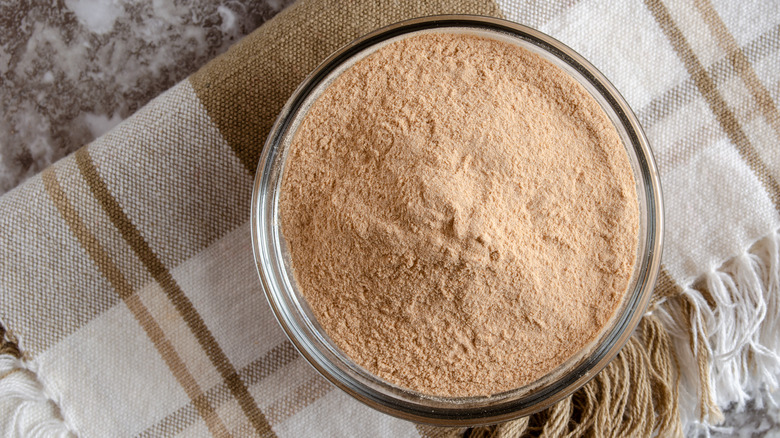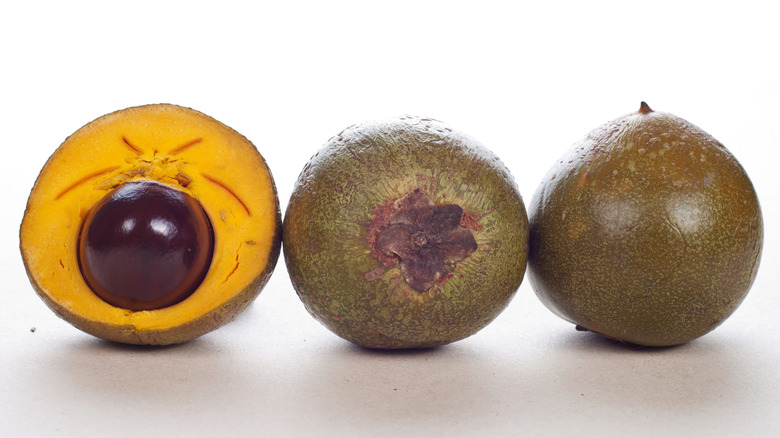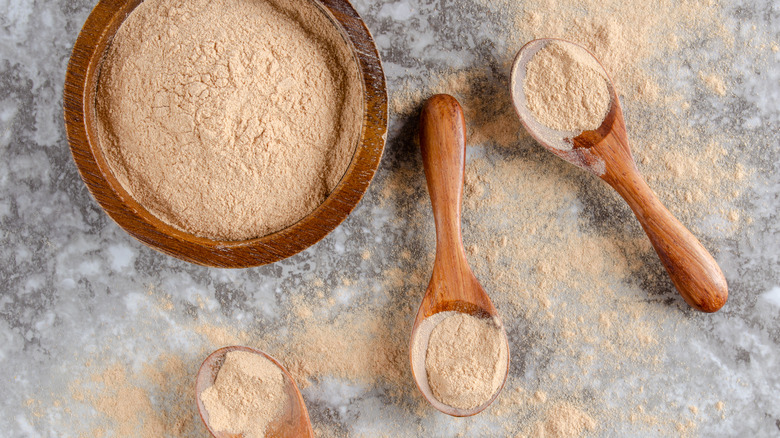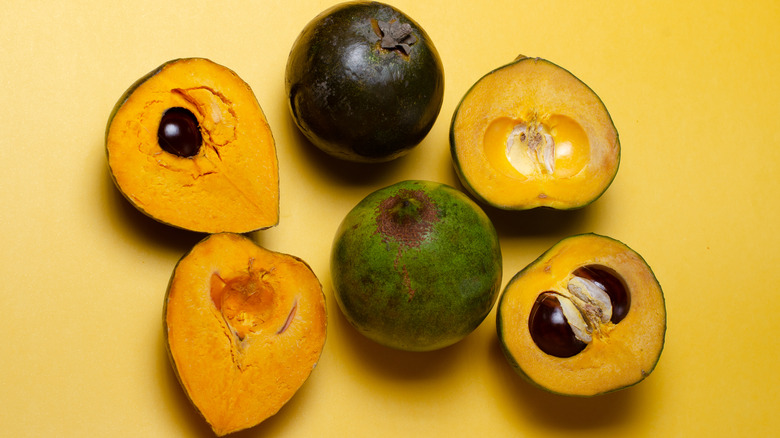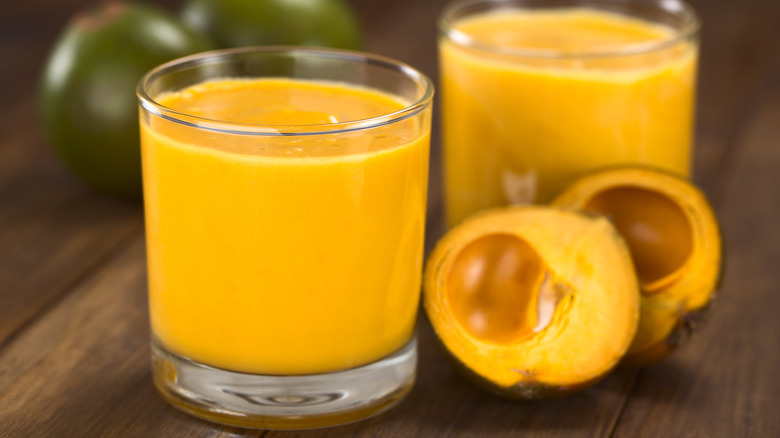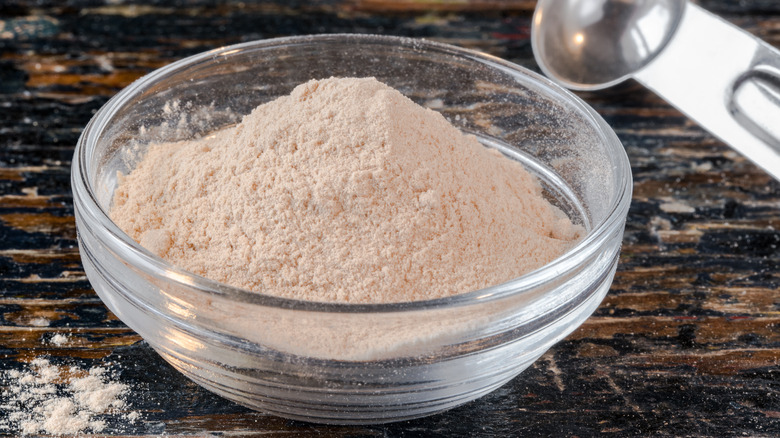The South American Sweetener You May Find In Nut Milks
Whether you love the taste of nut milk or drink it for health-related reasons, there are so many different options on the market these days that you're sure to find one that fits your needs. The widespread availability of nut milks and other milk alternatives is no coincidence, as companies are simply giving the people what they want. For the year ending in June 2022, retail sales for plant-based milk in the U.S. grew to almost $2.3 billion (via FoodNavigator-USA).
It can be tough to figure out which nut milk to start with if you're just now dipping your toe into this world. There's a huge variety to choose from: almond, cashew, hazelnut — just to name a few. This range expands as you venture outside the U.S. and find options that are made with ingredients that aren't common stateside. For example, tiger nuts (which are actually tubers) are the prime ingredient in Valencian horchata – a milky drink enjoyed by locals in the Spanish city, per Smithsonian Magazine. And if you take a trip to South America, you may find nut milk flavored with this type of sweetener.
What is lucuma powder?
Lucuma powder is a sweet ingredient that's made from the fruit of the lucuma tree (the scientific name is pouteria lucuma), per Trade Winds Fruit. The subtropical tree is native to the Andes mountains across Chile, Peru, Bolivia, and Ecuador, and it typically grows to be between 25 and 50 feet in height. Although it may not be super popular here in the U.S., lucuma has been a part of South American culture since as far back as 100 A.D., when indigenous communities in Peru carved images of the fruit into vases (via FreshCap Mushrooms). In fact, it's so ingrained in Peruvian culture that more than 26 villages in the country are named in honor of the fruit, according to Producers Market.
According to the Encyclopedia of Food Sciences and Nutrition, lucuma trees are part of the sapotaceae family, which includes other fruit-bearing trees and shrubs that thrive in tropical regions. This classification makes the lucuma tree a close relative of trees that have their barks harvested to produce chewing gum and gutta-percha — a material used to seal root canals (via ScienceDirect). However, the lucuma fruit couldn't appear more different from a dental filling. Dubbed the "gold of the Incas," per FreshCap, the fruit is about two to three inches in diameter, Rennie Orchards shares. It looks like a green avocado on the outside — and even contains a brown pit too — but the flesh inside resembles that of a vibrant gold mango.
How is lucuma powder made?
The ideal growing conditions for lucuma trees are warm — but not hot — environments, which is why they thrive in South American climates. Specifically, Rennie Orchards explains that they grow best where the temperature is between 50 to 80 degrees Fahrenheit. It can take three to five years for a lucuma tree to produce fruit, and the fruit itself can take up to nine months to mature after pollination. It's important to harvest lucuma fruit at exactly the right time; otherwise, it falls to the ground and splits from over-ripening, per Laurie Meadows.
Once the fruit has been picked, it can be transformed into lucuma powder. The ingredient is made by dehydrating the fruit at low temperatures, which keeps its nutrients intact (via Mindbodygreen). After the flesh is dried out, it can be ground into a powder. Depending on the producer, this powder may also undergo a sterilization process to curtail bacterial growth, per Peruvian Nature. And there are brands that offer organic and socially responsible options, such as Healthworks, which works with sustainable farms and aims to reduce waste and energy usage.
Fresh lucuma vs. powdered lucuma
While lucuma powder is by far the most popular way to consume this sweet fruit, it is possible to eat it fresh as well (via Specialty Produce). All you need to do is peel it, throw away the seed, and scarf down the remaining flesh — like you would do with an avocado. However, it may not be too appealing to eat the meat of a lucuma fruit by itself. Cook Eat Live Love explains that the inside resembles the yolk of a hard-boiled egg in both appearance and texture. In fact, another name for lucuma is eggfruit.
Aside from consuming the fruit straight, you can also find it cooked into pastes, jams, pastry fillings, syrups, and preserves. In Peru, it's also commonly blended into shakes and smoothies. However, lucuma powder is undoubtedly where this ingredient shines. After the flesh has been dehydrated and milled into a powder, it becomes much more versatile — ready to incorporate into recipes as a substitute for more traditional sweeteners.
What does lucuma powder taste like?
The lucuma fruit tastes slightly sweet, and while it may look like a cross between a mango and an avocado, its flavor and texture are completely different. Fresh lucuma meat is actually a bit dry and crumbly, per MasterClass.
Lucuma powder, on the other hand, has a sweet but wonderfully complex flavor profile with notes of sweet potato, butterscotch, and maple syrup (via Rennie Orchards). For this reason, though it's typically used to sweeten recipes, it's not an exact replacement for white sugar in certain cases. For example, lucuma powder may not be the best way to sweeten coffee, as it will lend a fruity, caramelized flavor to the brew, per FreshCap. And the powder also doesn't have the same level of sweetness when compared to sugar or honey. To replace brown sugar in a recipe, you'll need to use twice as much lucuma powder (via Producers Market).
How to use lucuma powder
Once you've accepted that lucuma powder won't taste exactly like white sugar, the uses for this ingredient are a bottomless pit. One of the most common ways lucuma powder is utilized is to sweeten commercially produced nut milks (via The Spruce Eats). However, it's pretty easy to whip up your own lucuma-sweetened nut milk at home as well. Just stir a few spoonfuls of the powder into your almond milk (or any other nut milk of your choosing), and it will give the drink a mild butterscotch flavor, per Mama Natural.
But nut milk isn't the only beverage that pairs well with this powdered fruit. You can stir lucuma powder into almost any liquid to give it a boost of sweet flavor, including smoothies, juices, yogurt, tea, and more. It also holds up well in desserts, such as chocolates and cakes and other baked goods, and as a topping for oatmeal or fruit salads. If you want to use the ingredient like the South Americans do, however, try making lucuma ice cream — the number one flavor for the frozen treat in Peru, ranking above even chocolate and vanilla (via Lucuma Designs).
While this sweetener is incredibly versatile, Cook Eat Live Love suggests keeping two things in mind when incorporating it into recipes: Lucuma powder may need a vigorous whisk to mix in completely, and it doesn't possess the same bright sunset color of the fresh fruit.
Where to buy lucuma powder
If you're in Peru or another South American country, you should have no trouble finding lucuma. In Peru, the fresh fruit is available at most markets from January to April and lucuma powder is widely sold, per Lucuma Designs. You could even visit a Starbucks in the country to try the bright yellow Lúcuma Crème Frappuccino. But what about here in the U.S.?
Because the lucuma fruit ripens quickly and is too delicate to travel from South America to the U.S., finding it in its fresh form stateside is unlikely. Some American farmers do grow lucuma trees but only locally in California and Hawaii, per FreshCap. Luckily, it's much easier to buy the powdered form. Big grocery store chains may not always have it, but you can get it online from Amazon and specialty shops, such as Swanson.
If you're looking to buy lucuma powder in person, try health food stores or Latin grocery stores (via MasterClass). Once you get your hands on it, the powder can last a long time. Make sure to store it in a sealed bag away from heat, direct sunlight, and moisture, and your lucuma powder can last up to three years, per Sunburst Superfoods.
Nutritional information about lucuma powder
While lucuma powder is widely used as a sweetener and sugar substitute, it's healthier than white table sugar in a few key ways. The powder isn't totally sugar-free, but there are claims that its glycemic index is lower than that of regular granulated sugar, according to WebMD. For this reason, this ingredient may not be as likely to spike your blood sugar, making it a particularly appealing option for people with diabetes.
In addition, the sweetener is more nutritious. Healthline shares that the powder has soluble and insoluble fiber, which can help with digestion and the growth of good-for-you gut bacteria, as well as calcium, iron, and vitamin C. Although lucuma doesn't contain a significant amount of these vitamins, it still has more than many other types of sugar. Adding this powder to your food may also give you a boost of antioxidants and micronutrients that support heart health, per Mindbodygreen.
Research is still limited on the long-term health benefits of using lucuma powder, but its nutritional profile makes it a healthier sugar alternative worth considering.
